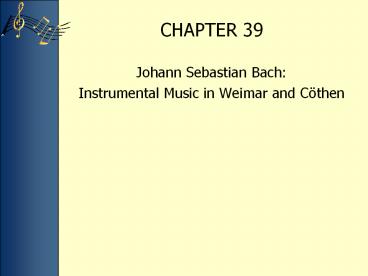Johann Sebastian Bach: - PowerPoint PPT Presentation
1 / 13
Title:
Johann Sebastian Bach:
Description:
Here, the melody is in the soprano, while the other voices provide counterpoint. ... Countersubject: a theme that serves as a counterpoint to the subject. ... – PowerPoint PPT presentation
Number of Views:720
Avg rating:3.0/5.0
Title: Johann Sebastian Bach:
1
CHAPTER 39
- Johann Sebastian Bach
- Instrumental Music in Weimar and Cöthen
2
Johann Sebastian Bach
- Born in central Germany from a family with a long
musical tradition, J.S. Bach first studied music,
the humanities, and theology in private Lutheran
church schools at Eisenach, Ohrdruf, and
Lüneburg. After serving as organist in Arnstadt,
he moved to more promising positions in
Mühlhausen and then in Weimar.
3
- In Bach's time, the organ occupied a central
place in German society and particularly in the
Lutheran religious service. Then and now, the
Germans were known for their excellence in the
manufacture of pipe organs. - Rank a group of similar-sounding organ pipes
(violins, trumpets, oboes, etc.). - Stop a small wooden knob that activates each
rank when pulled.
4
Bach in Weimar
- During his time in Weimar (1708-1717), Bach wrote
most of his great works for organ. Among them,
the Orgelbüchlein (Little Organ Book) is a
collection of forty-six choral preludes that Bach
might have intended as - a repertory of pieces for the organist to play in
church - a demonstration on how to compose a choral
prelude on a given tune - a way to develop the organist's technique through
extensive use of the pedal. - Recall that a choral prelude is an ornamental
setting of a pre-existing choral tune to be
played on the organ before the singing of the
choral by the congregation.
5
"In dulci jubilo"
- Known today as the Christmas carol "Good
Christian men rejoice," this choral prelude from
the Orgelbüchlein sets an old Gregorian chant.
Here, the melody is in the soprano, while the
other voices provide counterpoint. Moreover,
Bach adds two canons, one between soprano and
bass, and the other between alto and tenor.
6
- Pedal point a sustained or continually repeated
pitch, usually placed in the bass and sounding
while the harmonies change around itso called
because of its original association with the
pedal of the organ. Bach often concludes his
keyboard works with a pedal point.
7
Bach in Cöthen
- Bach was appointed Kappellmeister (chief court
musician) at Cöthen in 1717, where he served
until 1723. This position was very much a step
up from that of organist in Weimar. Much of his
chamber and orchestral music dates from this
period. - Two- and Three-Part Inventions two sets of
didactic pieces along the lines of simple fugues.
Each collection contains fifteen works all in
separate keys.
8
The Well-Tempered Clavier
- A collection keyboard pieces by Bach in two books
each containing twenty-four pairs of preludes and
fugues arranged by key in ascending order. As
the title suggests, Bach's "clavier" should be
tuned to play in all tonalities. - Equal temperament a division of the octave into
twelve equal half-steps.
9
- Subject the energetic, memorable theme with
which a fugue begins. - Countersubject a theme that serves as a
counterpoint to the subject.
10
- Exposition the opening section of a fugue in
which the subject is presented in imitation in
each voice. - Episode the section(s) that follows the
exposition and subsequent statements of the
subject characterized by melodic sequence and
modulation. - Fugue a contrapuntal piece for two, three, or
four voices, which begins with the presentation
of a subject in imitation in each voice
(exposition), continues with modulating passages
of free counterpoint (episodes) and further
appearances of the subject, and ends with a
strong affirmation of the tonic key.
11
- Invertible counterpoint a compositional
technique in which two voices exchange motives.
12
- Picardy third the sudden shift to a major chord
at the end of a composition in a minor key. - Obbligato a term indicating that a composer has
written a specific part for an instrument and
intends it to be played as written. Bach often
wrote out obbligato accompaniment parts for the
harpsichord instead of a single figured bass line.
13
- Bach's Brandenburg Concertos are a set of six
concertos for "several instruments" written for
the most part in Cöthen. They are dedicated to
the Margrave of Brandenburg, whom Bach met during
a visit to Berlin where he was sent to pick up a
large new harpsichord. It was this harpsichord
that Bach himself likely played during the
premier of Brandenburg Concerto No. 5.





![[PDF]⚡Download ⚡ Johann Sebastian Bach: The Learned Musician PowerPoint PPT Presentation](https://s3.amazonaws.com/images.powershow.com/10069381.th0.jpg?_=20240703079)

























